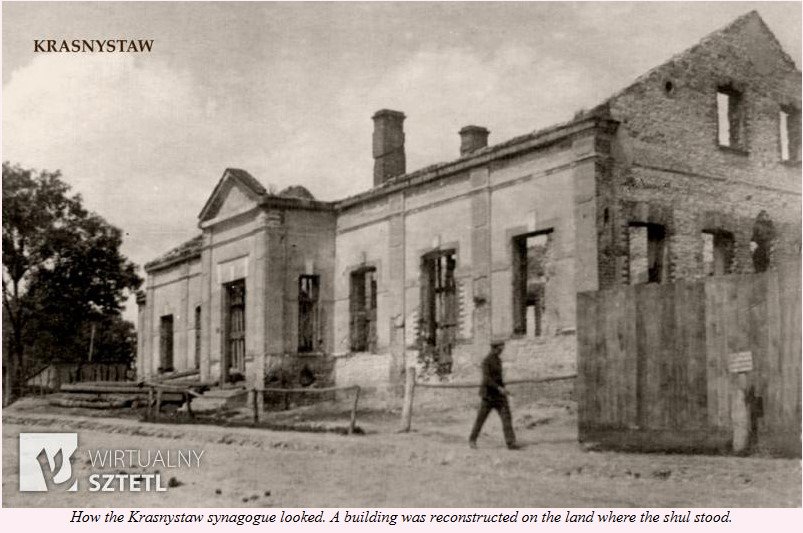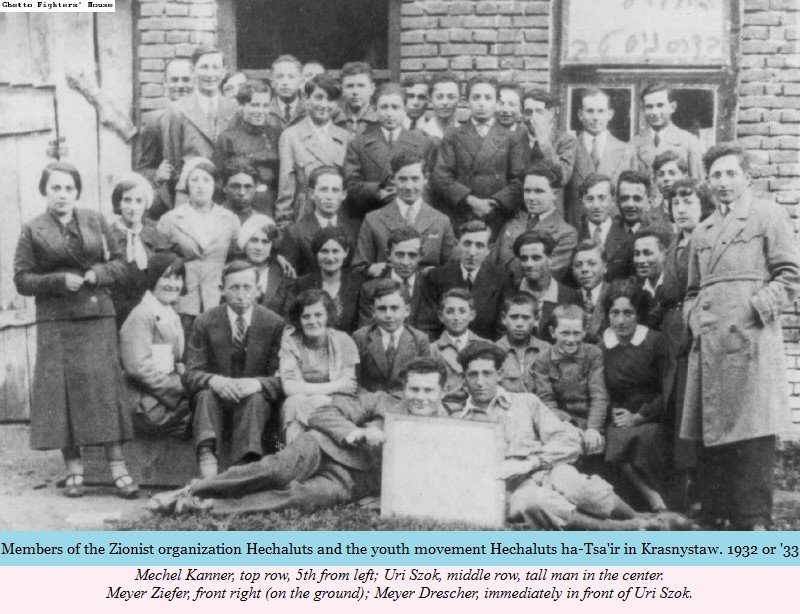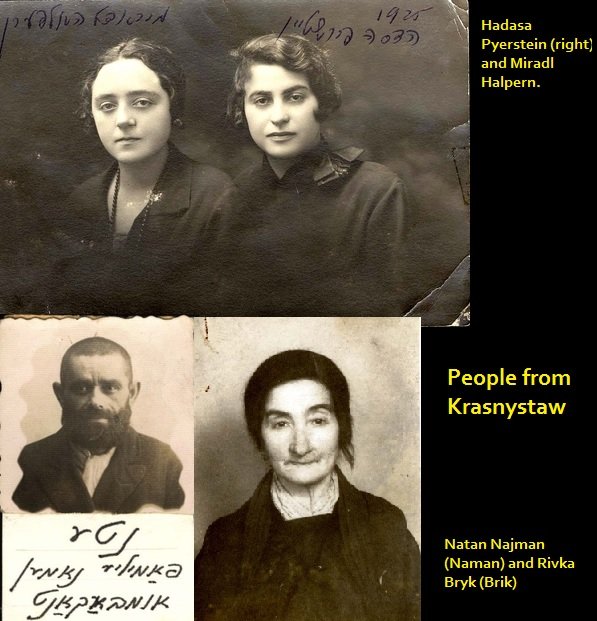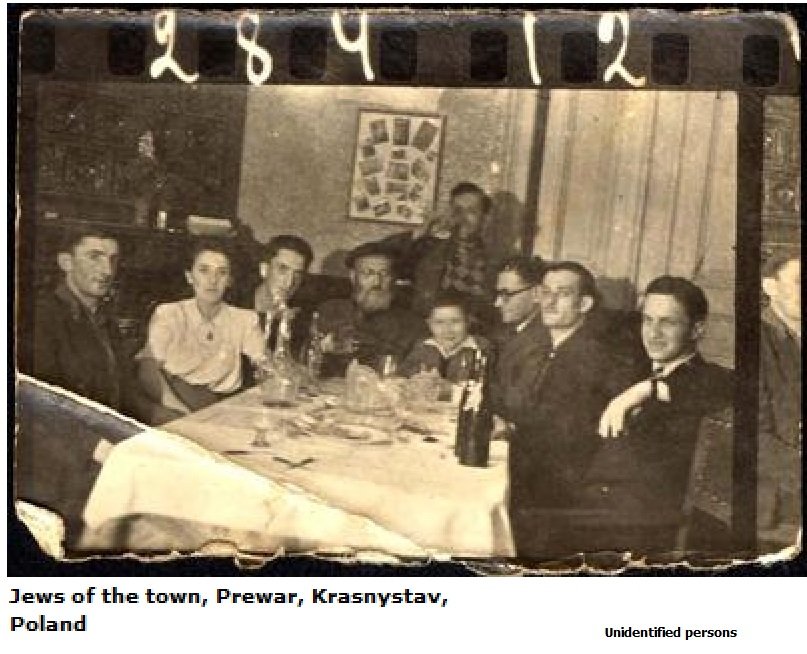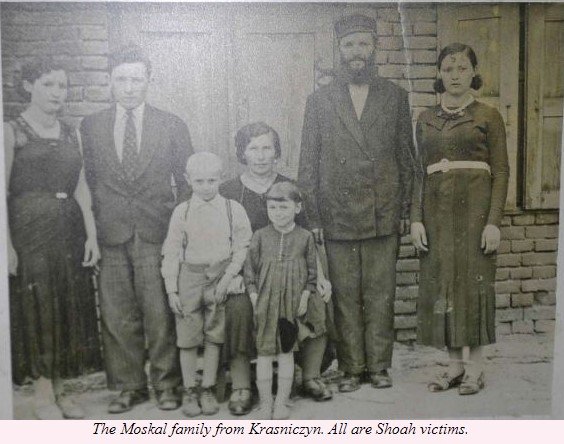Remember Jewish Krasnystaw
Pronunciation: Kraz-niss-tav
HISTORY OF JEWISH KRASNYSTAW
Krasnystaw is a city in southeast Poland, with a population of 19,615. The town is 30 km. southwest of Chelm and 31 km. north of Zamosc. It's also 52 km. SE of Lublin. The first mention of Krasnystaw Jews is in 1548. However Jewish merchants were visiting the town before that, in the 15th century.
In 1394, Krasnystaw was granted the status of town, gaining economic advantages, including the right to set up a weekly market and three fairs a year. Rapid growth was due mainly to trade connections with Danzig (Gdansk), which took place over the Wieprz River, which spills into the Wisla River. Through the river, the town became a station for barges loaded with grain, wood, and commercial goods. In 1569 there were 339 wood houses.
From the beginning, the Krasnystaw Jewish community was struck with antisemitism in town. From 1554 to 1862 there was a ban on Jewish settlement there. It wasn't until 1862 that bans on Jewish residency were removed from the town. Still, some Jews managed to reside there. In 1827, 11 Jews are recorded as living in the town. By 1857, the number grew to 151 Jews out of around 3,500 total residents (or four percent). Out of 4,750 residents in 1897, 25 percent -- or 1,176 -- were Jewish. Eighty percent of the local trade was produced by the Jewish community. By 1921, the community had around 8,500 residents, including 1,754 Jews. In 1917,
of 24 councilors on the Krasnystaw town council, 3 Jews were among them: Chaim Bergerman, Icek Hochman and Judka Rozenblat. There was an active Zionist movement in town, and many Jews in town supported the Agudat Israel organization, led by Abram Szok. The Agudath Israel board included: Chaim Apozdawer, Abram Baum, Bencjan Halpern, Lipa Rajchman, Hersz Sztamer, Jakub Tregier, Abus Warman, Mendel Warszmiler. Lipa Rajchman was also on the town council at various points. The Josef Trumpeldor Association of Jewish Scouts had 54 members. The Labor Bund in town was run by Abram Zygielbaum. The Communist Party of Poland, managed by Ruchla Frydman, a dressmaker, also had a branch in Krasnystaw. In town, a Merchant Loan Bank was operated by Szmul Perelmuter. A Mercantile Credit Bank led by Icek Zygelszyper was opened in 1926. The Bruder Hilf Charity Association, which provided financial support in the form of interest-free and short-term loans, had 25 members. Toward the end of 1917, the Association of Jewish Tailors and Shoemakers, which had 40 craftsmen, was formed in Krasnystaw.
A bookstore, situated at Cerkiewny Square and owned by Chil Szolson, operated in Krasnystaw from 1906. There were two typographic houses in the town; one was owned by Szolson and the other by Rafal Kasner. The I. L. Perec library, which gathered about 500 Jewish and Hebrew books, operated in Krasnystaw. Its founders were Mendel Rajchman and Mosze Prechter. Hadasa Fajersztajn, who also helped with Zionist activity among Jewish girls, ran the library. In 1913, five cheders, attended by 98 students, operated in the town. The first cheder, created in 1889, was managed by L. Guterman and had 23 students. Other cheders were operated by U. Goldman, who provided education to 22 boys; and P. B. Turobiner, who had 18 pupils. In 1892, F. Ajnwojnier formed another, fourth, cheder with 23 students. The fifth cheder was established in the year 1904; its owner was M. Berger and it had 23 students. In 1932, there were six cheders in Krasnystaw attended by 73 Jewish boys. Other Jewish children attended a state public school. From 1921 to 1930, 319 students, including 79 children of Jewish origin (24.76% of all students), attended Primary School No. 1 in Krasnystaw. Between the years 1930-1939, the school had 326 students (67 -- 18.51% of Jewish descent). There were approximately 2,200 Jews living in Krasnystaw when the war broke out, which represented 20% of the town's total population.
Some of the town residents are noted for their occupations: Feldman had a board yard; Cung -- bottling plants; Kozak -- a mill; Stucajger -- a shop with leather and tailor's products, Karp -- a fishing tackle shop; Rajchman -- a shoe shop for the elites; Pinker and Goldstein -- bakeries. Lewkowicz owned a tailor's shop; Zontag -- a photographer's workshop; Zunger sold sweets and drinks; Merenstein opened a grocery shop with alcohol; Fleszer traded in knick-knacks; Halpern had a textile shop; Mandeltort had a photographer's workshop. The wealthiest residents were those who ran mills. Szymon Lejba owned a steam mill where he employed 11 workers. Milcia Cypkiewicz opened a fashion school in 1913, and Bencion Kepfisz opened a wicker workshop.
Residents of the town who held positions within the community in 1930 included: grave-digger L. Fogelfus; janitor J. Blumsztajn; secretary B. Buchbleter; school employee J. Sztunsajgier; synagogue sextons M. Puterman, J. Sztundajgier; Rabbi Naftali Czerwon; cantor B. Frachter; and schochets Majer Apozdawer and Jakob Langman. Prayer houses were operated by Szul Knobel, Lejb Feldman, and Berek Zalcman.
Villages near Krasnystaw also had a Jewish population in 1939: Borowica (10 Jews), Gorzkow (800 Jews), Krasniczyn (500 Jews), Lopiennik Gorny (unknown number of Jews), Nielisz (20 Jews), Siennica Rozana (150 Jews), Stara Wies (unknown number of Jews), Tarnogora (200 Jews), Tarzymiechy (unknown number of Jews), and Zakrecie (unknown number of Jews). The Krasnystaw Jewish population in 1939 was 2,200.
REMEMBER JEWISH GORZKOW
In 1921, Gorzkow had a population of 434 Jews. In 1939, the number was likely between 500 and 800. Jewish settlement took place in the 19th century. There was a Bet Midrash (religious school) and a shochet (ritual slaughterer), who ruled on religious matters and taught the children. At the beginning of 1940, a Judenrat was established in town, led by Izrael Edelsztajn and Chaim Kajzman. Additional Judenrat members included Josef Kajzman, Leib Goldstein, Zindel Honigman (a hero of the Holocaust), Mattias Orland, Szlomo Cymerman, Daniel Wasser, Ajzyk Farber, and Meir Merensztajn. In the spring of 1940, and again at the beginning of 1942, Jews from Gorzkow were sent to slave labor at Belzec, which was at that time still a labor camp. Young men from the village were also sent to slave labor at Trawniki. In May or November of 1942, the Germans assembled the Jews of Gorzkow and the nearby villages in the market square, and they were marched 12 km. to the Izbica transit ghetto -- the assembly point for all the Jews of the area. In the autumn of 1942, and the start of 1943, all the inhabitants of the Izbica ghetto were sent to the gas chambers at Belzec death camp.
REMEMBER JEWISH SIENNICA ROZANNA / TARNOGORA .
The Jewish populations of Siennica Rozanna and Tarnogora in 1939 were approximately 150 Jews in Siennica and between 100 and 200 Jews in Tarnogora.
In 1743, Jews were forbidden to settle in Tarnogora and in Izbica, and very few managed to circumvent the prohibition. In 1759 one Jewish family was settled in Tarnogora, and towards the end of the 18th century only 5 Jewish families were living there. Even after 1862, when the prohibition was cancelled altogether in Poland, few Jews settled in Tarnogora because opportunities for earning a wage were sparse. In the 1930s, antisemitic propaganda intensified in Tarnogora -- Jews were attacked in the streets and Jewish peddlers passing through villages with their wares feared for their lives.
In March or April of 1942, 272 Jews from Siennica Rozanna were sent to the gas chambers at Belzec.
In March and April of 1942, thousands of Jews from the Tarnogora area (many had been deported to the area from Germany or Czechoslovakia) were expelled to Belzec.
REMEMBER JEWISH KRASNICZYN
Krasniczyn, another nearby village, had 116 inhabitants in 1676 and the Jewish population built their houses mainly at the back of the eastern side of the market, where there was also a synagogue. In 1734, a fire in Krasniczyn destroyed the house of prayer, mikvah, and nine houses located in the vicinity of the market. In 1756, there were 14 Jewish properties (with houses) in the town. Fifty Catholic and 24 Jewish houses were in Krasniczyn in 1777. In 1910, the settlement had a wooden synagogue for approximately 300 people, mikvah and a Jewish cemetery. The synagogue district included the villages of Anielpol, Boncza, Brzeziny, Drewniki, Czajki, Majdan Surhowski, Surhow, and Wojciechow.
Historic sources list the names of some of the residents of Krasniczyn. In 1910, these included Abram Borek, Abram Cukier, Sara Cukier, Berko Cukier, Lajla Aizenberg, Jankiel Blat, Frankel Bubiel, Moszko Tuchman, Tapchip Aizenberg (age 38), Jankiel Warman, Herszko Rajc (age 38), Szmul Gros, Abram Fiterman, Herszko Tuchman, Abram Hersz Zimner (age 50), and Rabbi Rafal Kliger. The following Jews lived in nearby villages of synagogue district: Benjamin Zilbersztajn from Uchanie, who lived in Anielpol; Simcha Sziblowicz in Boncza, Majer Szmul Blat from Izbica, in Brzeziny; Majer Lichter from Izbica in Drewniki; Szloma Ehrlich and Chaim Goldfarb in Krasniczyn; Szloma Gdala Blatt and Abram Mangiel in Surhow; Berek Taj in Majdan Surhowski; and Lejzer Bergier from Grabowiec and Wulf Litman from Izbica in Folwark Wojciechow.
Krasniczyn had 610 inhabitants in 1921 and 540 of them (83%) were Jews. There were five cheders in the town. The Jews owned most of the shops and craft workshops (tailoring, leather stitching), as well as slaughterhouses, bakeries, hulling mills and a small furniture factory. Occupations in town during the pre-war period included: Hersz Fuks and C. Samet in groceries and S. Apel in egg selling; the Becher and Lichtensztajn families had slaughterhouses; Icek Goldwasser, the wealthiest man in town, had a haberdashery, as did G. Cukier, B. Szydlowicz, Sz. Zymner, and J. Sylberman. Ready-made suits were created by H. Moskal and L. Rubinsztajn. Mr. Fuks had carbonated waters. Processed grains were sold by B. Becher, Sz. Fuks, and Sz. Gros, and leathers by S. Klajner, D. Zylberman, and Ch. Goldbard. Crop trade was conducted by J. Becker and M.J. Blat; cattle trade by A. Cukier; forest exploration by A. Aszkenazy, J. Nirenblat, and M. Becher. A tailor shop was run by Ch. Birbaum, A. Gros, N. Helfman, K. Lederman, D. Moskal, and H. Moskal. A bakery was run by J. Cukier; a glazier shoppe by Mr. Warman; and a leather-stitchery shoppe by Aron Zimner.
After the outbreak of the Shoah, the Krasniczyn Ghetto was established in 1940. In nearby Surhow, a labor camp for Jews from Poland, Austria, Germany, Slovakia, and Czech Republic, was established. The camp was formed with the purpose of regulating and meliorating the Wojslawka River. It was dissolved in August 1942 and the imprisoned Jewish slave laborers were deported to the gas chambers at the Belzec Death Camp.
While only 500 Jews originated in the Krasniczyn Ghetto, by March 1941 the number became close to 1,000 when 500 Jews were transported from Czechoslovakia to the Krasniczyn Ghetto. But by April, the number again decreased after the transport to Belzec. Additionally, 200 Jews from Izbica came to the Krasniczyn Ghetto in April 1942 and approximately 1,000 Jews from the Third Reich on April 28, 1942. Another group of Jews was deported to Krasniczyn on May 3, 1942.
In May 1942 the German military police gathered 327 Jews in front of the school building. Afterward, they were driven on foot to Krasnystaw (17 kilometers from Krasniczyn) from where they were transported by a train to the gas chambers at Belzec. The Krasniczyn Ghetto was liquidated in June of 1942. The Germans killed 200 Jews on the local cemetery and those who survived were driven on foot to Izbica from where they were taken to the gas chambers at Sobibor Death Camp.
Among those who were forced to walk to Izbica were: Icek Goldwaser, village administrator, Nuta Helfman and Rabbi Szmuel Oselka with his wife. After the Jews from Krasniczyn had been deported, the Germans destroyed all Jewish properties, together with the synagogue.
KRASNYSTAW DURING THE HOLOCAUST
The Nazis captured Krasnystaw on September 14, 1939. A ghetto was established and the 1,690 Jews living in Krasnystaw as well as some Jews from Germany and Czechoslovakia, were forced into the ghetto in August 1940. The ghetto had 2,000 prisoners in 1942, including Jews from Grodziec, Rzgow, and Skulsk that had been sent there on March 9, 1941. The Krasnystaw Judenrat was established at the beginning of 1940. Judenrat members consisted of: Lipe Bloch, Issachar Rozenbojm, Alter Katz, David Zylbercan, Lipa Reichman, and Avigdor Feldman. Michael Szolson, a prominent leader of the Krasnystaw community who also was on the Judenrat, was among the first Jews deported and murdered at Sobibor after Judenrat chairman Lipe Bloch and him got into a dispute. His date of death is May 15, 1942. Most members of the Jewish police were friends or relatives of Judenrat members. The Jewish police included Bencion Rosenblatt, Moshe Szmaragd, Josef Zylbercan, and Zanwel Mittelman.
Near the Borek Forest, the Nazis operated a labor camp which housed Jews deported from Czechoslovakia to Krasnystaw. Almost all of them were executed there. In May of 1942, almost 3,000 residents of Turobin, Poland were relocated to Krasnystaw and subsequently taken to the Sobibor Death Camp.
On April 12, 1942, as many as 600 Jews living in Krasnystaw ghetto were expelled to Izbica together with Jews from nearby communities, such as Siennica Rozana, Rybczeice, and Krasniczyn.
On April 16, 1942, Salomon Griffen, head of the JSS in Fajslawice, reported the 220 Jews in his municipality, half of them employed at a German estate, were unscathed by the deportation, which had impacted on Jews in every town and settlement in the Kreis and in the neighboring Lopiennik Gorny and Rybczewice municipalities. The deportees were probably marched directly to the Izbica railway station and then sent to be gassed at the Belzec death camp.
On June 18, 1942, Michal Szolsohn's deputy reported to JSS leaders in Krakow that no Jews that no Jews remained in Krasniczyn, Wysokie, and Rudnik -- or in the Lopiennik, Rybczewice, and Zakrzew municipalities. Jews in Krasnystaw were employed mainly in clearing possessions from the ghetto. Some of the clearing squad was sent to the Trawniki labor camp, probably in late August 1942. Also in August of 1942, some Jewish agricultural workers in Krasnystaw were sent to the Sobibor death camp.
In October 1942 the Germans transferred remaining Krasnystaw Jews to the Izbica ghetto. Jews in the Izbica transit ghetto were typically shot on the spot or relocated to Belzec's gas chambers.
In 1941, the synagogue at 3 Czyste Street was destroyed. The Jewish cemetery on Chelm Street, founded around 1890, still has between five and ten visible grave stones.
Please review the site content below. Zachor - We Remember.
------------------------------------------------------------------------
[Surnames and Researchers] [History] [Education & Culture]
[Organizations and Associations] [Wikipedia - Krasnystaw]
[Holocaust] [Borek Forest Labor Camp] [Jewish cemetery]
[List of Martyrs (incomplete) from the Yizkor Book]
[Cemetery] [Synagogue] [Notable Residents]
[Family Research in Southeast Poland]
------------------------------------------------------------------------
LINKS
Join the Krasnystaw group on Facebook!
Town of Krasnystaw:
An account of Gorzkow during the Holocaust
Izbica near Krasnystaw
Krasnystaw eGroup
Photos of Krasnystaw Today
Families of Krasnystaw:
Fuks family
Szok family
Zigelboim family
Majdan Tatarski Ghetto Victims (Lublin) from Krasnystaw and Gorzkow:
Chaja Rojza Cynamon
Hudla(?) Mirla Cynamon
Ita Fleszler
Chaim Handelsman
Moszek Lejba Lejwand
Czarna Marder
Icek Messinger
Estera Messynger
Chana Bergajzen Nirenberg
Matys Szulman
(source: Brama Grodzka - Teatr NN)
Rabbis of Krasnystaw:
Josef Malowertaw, 1860
(unknown) Wienhab
Yosef Reznik, cantor
Rafael Rozenzwajg, cantor
Avraham Rojtsztejn
Survivors of Gorzkow:
Judel (Judka) Goldsztejn
Brucha Betty Honigman
Zyndel Honigman
Moshe Merensztajn
Frida Sztuden (Shtuden)
Hershel Zimmerman (Harold Werner)
Survivors of Krasnystaw:
(includes people from Zolkiewka)
Necha Zycer Adelsberg
Moshe Adelsberg
Eliyahu Adelsberg
Nuchem Norman Adelsberg
Szloma Berger
Golde Fingerhut Blustein
Ber "Dov" Freiberg
Mayer Drescher
Leibel Leon Feldhendler
Szymon Frydlinski
Maria Binder Greber
Fajwel Hershman
Josef Hershman
Moshe Hochman
Samuel Kac
Michael Kanner
Felik Kestelman
Jafa Klocman
Esther Knobel Tuzman
Aniela Knobl
Jakub Knobl
Lejzor Korenfeld (went to Israel)
Maria Kozlowska
Bernard Kratz
Samuel Kratz
Giselle Kurz
Kate Langer
Raquel Lew de Latarowski
Sala Lehrman
Samuel Lerer
Itzhak Lichtman
Annette Lotersztajn
Bernard Page
Rafael Pelc
Icek Rochman
Marja Schneidmesser
Irving Schock (Szok)
Simon Stemer
Tadeusz Sterngast
David Stundzeiger (video testimony)
Berek Szarf
David Szarf (Scharf)
Usher Szok
Yitzchak Szok
Mila Szterenzys
Josef Wagner
Shalom Weitz (Wajc)
Pola Eisenstein Zacman (or Zalcman)
Czeslaw Zalewski
Menachem Zinger
Hershel Zycer
Reuven Zygielbaum
Notable Residents:
Melvin Dresher
Avoth Yeshurun
Abraham Zygielbaum
Szmul Zygielbojm
Notable Descendants:
Jesse Eisenberg, American actor
Kaleil Isaza Tuzman, American entrepreneur
Righteous Gentiles:
- Jan Osiewicz hid the Knobel family of three
- Karol Olecha hid the Honigman family of four at Wielkopole
Genealogy:
Krasnystaw During the Holocaust
Jewish Records Indexing Poland - Krasnystaw
Jewish Vital Records in the Polish State Archives
Pinkas Hakehillot Polin: Gorzkow
Pinkas Hakehillot Polin: Krasnystaw
Remember Your Family:
Central Judaica Database - Museum of History of Polish Jews
Grandchildren of Holocaust Survivors on Facebook
Guide to the YIVO Archives
Holocaust News/Events from Generations of the Shoah Int'l
Holocaust Survivors and Victims Database
JewishGen Family Finder
JewishGen Holocaust Database
JRI-Poland: Search for Your Family
Museum of History of Polish Jews Introduction
Yad Vashem: Search for Your Family
Yad Vashem: Submit Names of Your Family Members
Yad Vashem Requests Photos of Shoah Survivors and Families
CONTACTS
U.S.: LublinJewish@gmail.com
Return to Lublin Index



